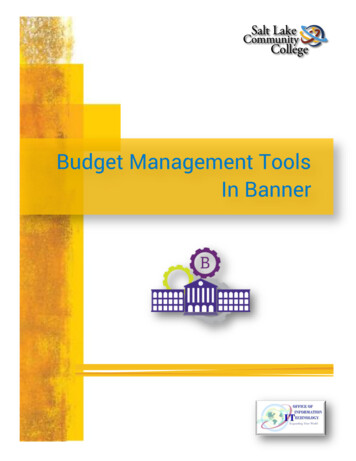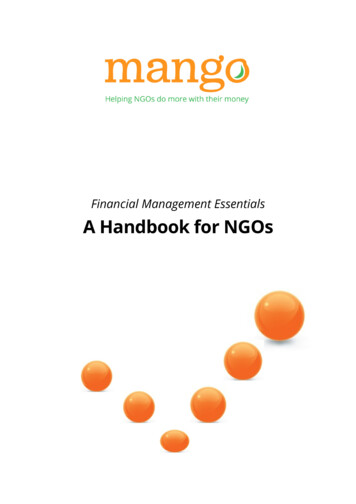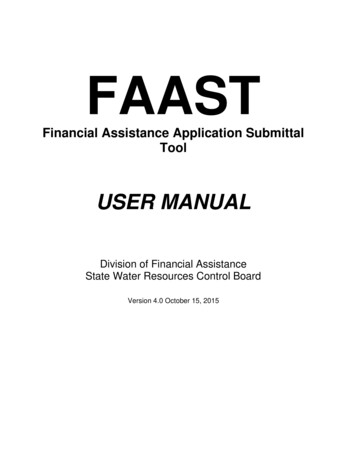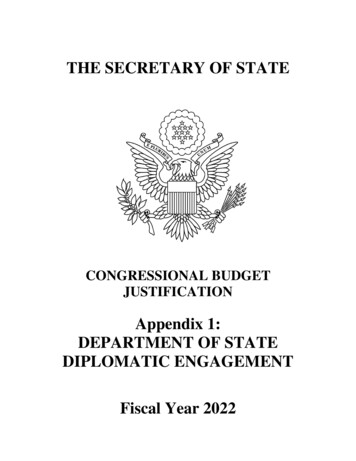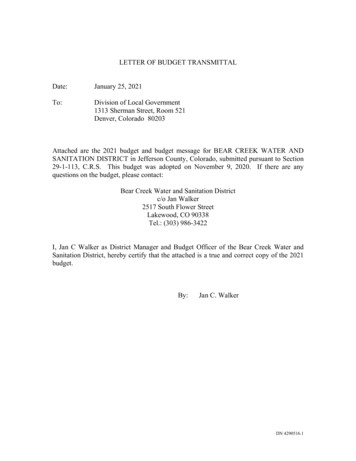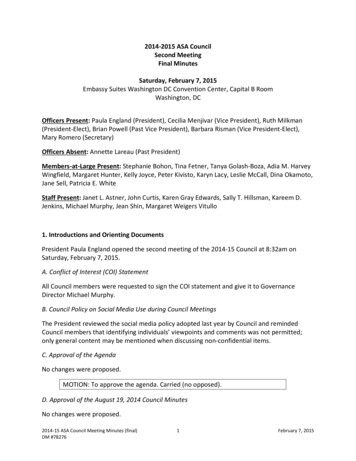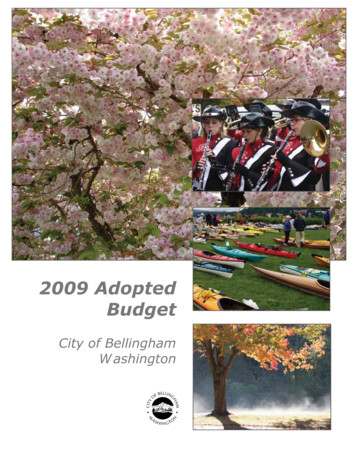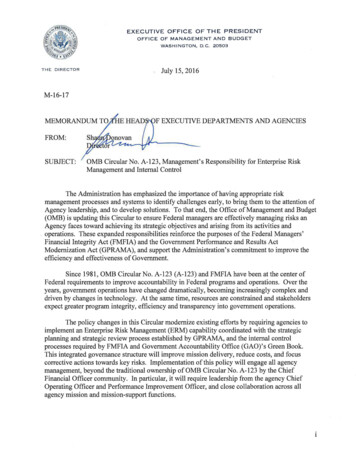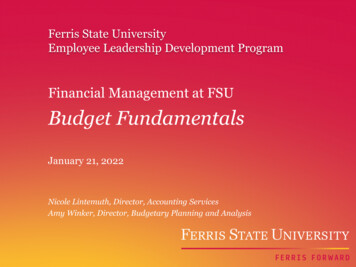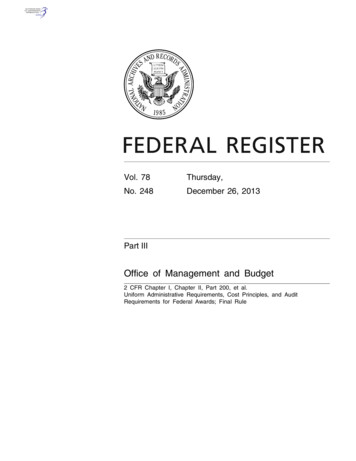
Transcription
Vol. 78Thursday,No. 248December 26, 2013Part IIIOffice of Management and Budgettkelley on DSK3SPTVN1PROD with RULES32 CFR Chapter I, Chapter II, Part 200, et al.Uniform Administrative Requirements, Cost Principles, and AuditRequirements for Federal Awards; Final RuleVerDate Mar 15 201018:36 Dec 24, 2013Jkt 232001PO 00000Frm 00001Fmt 4717Sfmt 4717E:\FR\FM\26DER3.SGM26DER3
78590Federal Register / Vol. 78, No. 248 / Thursday, December 26, 2013 / Rules and RegulationsOFFICE OF MANAGEMENT ANDBUDGET2 CFR Chapter I, and Chapter II, Parts200, 215, 220, 225, and 230Uniform Administrative Requirements,Cost Principles, and AuditRequirements for Federal AwardsExecutive Office of thePresident, Office of Management andBudget (OMB).ACTION: Final guidance.AGENCY:To deliver on the promise ofa 21st-Century government that is moreefficient, effective and transparent, theOffice of Management and Budget(OMB) is streamlining the Federalgovernment’s guidance onAdministrative Requirements, CostPrinciples, and Audit Requirements forFederal awards. These modifications area key component of a larger Federaleffort to more effectively focus Federalresources on improving performanceand outcomes while ensuring thefinancial integrity of taxpayer dollars inpartnership with non-Federalstakeholders. This guidance provides agovernmentwide framework for grantsmanagement which will becomplemented by additional efforts tostrengthen program outcomes throughinnovative and effective use of grantmaking models, performance metrics,and evaluation. This reform of OMBguidance will reduce administrativeburden for non-Federal entitiesreceiving Federal awards whilereducing the risk of waste, fraud andabuse.This final guidance supersedes andstreamlines requirements from OMBCirculars A–21, A–87, A–110, and A–122 (which have been placed in OMBguidances); Circulars A–89, A–102, andA–133; and the guidance in Circular A–50 on Single Audit Act follow-up.Future reform efforts may eventuallyseek to incorporate the Cost Principlesfor Hospitals in Department of Healthand Human Services regulations. Copiesof the OMB Circulars that aresuperseded by this guidance areavailable on OMB’s Web site at http://www.whitehouse.gov/omb/circularsdefault/. The final guidanceconsolidates the guidance previouslycontained in the aforementionedcitations into a streamlined format thataims to improve both the clarity andaccessibility. This final guidance islocated in Title 2 of the Code of FederalRegulations.This final guidance does not broadenthe scope of applicability from existinggovernment-wide requirements,tkelley on DSK3SPTVN1PROD with RULES3SUMMARY:VerDate Mar 15 201018:36 Dec 24, 2013Jkt 232001affecting Federal awards to non-Federalentities including state and localgovernments, Indian tribes, institutionsof higher education, and nonprofitorganizations. Parts of it may also applyto for-profit entities in limitedcircumstances and to foreign entities asdescribed in this guidance and theFederal Acquisition Regulation. Thisguidance does not change or modify anyexisting statute or guidance otherwisebased on any existing statute. Thisguidance does not supersede anyexisting or future authority under law orby executive order or the FederalAcquisition Regulation.DATES: Effective Date: This guidance iseffective December 26, 2013.Applicability Date: This guidance isapplicable for Federal agenciesDecember 26, 2013 and applicable fornon-Federal entities as described in thisguidance.FOR FURTHER INFORMATION CONTACT:OMB will host an informational webcastwith the Council on FinancialAssistance Reform and keystakeholders. Please visit www.cfo.gov/cofar for further information on the timeand date of the webcast and on theCouncil on Financial AssistanceReform. For general information, pleasecontact Victoria Collin or Gil Tran at theOMB Office of Federal FinancialManagement at (202) 395–3993.SUPPLEMENTARY INFORMATION:I. Objectives and BackgroundA. ObjectivesThe goal of this reform is to deliveron the President’s directives to (1)streamline our guidance for Federalawards to ease administrative burdenand (2) strengthen oversight overFederal funds to reduce risks of waste,fraud, and abuse. Streamlining existingOMB guidance will increase theefficiency and effectiveness of Federalawards to ensure best use of the morethan 500 billion expended annually.This reform builds on two years ofwork by the Federal government and itsnon-Federal partners: state, and localgovernments, Indian tribes, institutionsof higher education, nonprofitorganizations, and the audit communityto rethink and reform the rules thatgovern our stewardship of Federaldollars. The revised rules set standardrequirements for financial managementof Federal awards across the entireFederal government.These reforms complement targetedefforts by OMB and a number of Federalagencies to reform overall approaches togrant-making by implementinginnovative, outcome-focused grantmaking designs and processes inPO 00000Frm 00002Fmt 4701Sfmt 4700collaboration with their non-Federalpartners, in accordance with OMBguidance in M–13–17 ‘‘Next Steps in theEvidence and Innovation Agenda’’. Thisnew guidance plays an important role infostering these and other innovativemodels and cost-effective approaches byincluding many provisions thatstrengthen requirements for internalcontrols while providing administrativeflexibility for non-Federal entities.These provisions include mechanismssuch as ‘‘fixed amount awards’’ whichrely more on performance thancompliance requirements to ensureaccountability, and allow Federalagencies some additional flexibility towaive some requirements (in addition tothe longstanding option to apply toOMB to waive requirements) thatimpede their capacity to achieve betteroutcomes through Federal awards. Thisguidance will provide a backbone forsound financial management as Federalagencies and their partners continue todevelop and advance innovative andeffective practices.This reform of OMB guidance willimprove the integrity of the financialmanagement and operation of Federalprograms and strengthen accountabilityfor Federal dollars by improvingpolicies that protect against waste,fraud, and abuse. At the same time, thisreform will increase the impact andaccessibility of programs by minimizingtime spent complying withunnecessarily burdensomeadministrative requirements, and so reorients recipients toward achievingprogram objectives. Through close andsustained collaboration with Federaland non-Federal partners, OMB hasdeveloped ideas that will ensure thatdiscretionary grants and cooperativeagreements are awarded based on merit;that management increases focus onperformance outcomes; that rulesgoverning the allocation of Federalfunds are streamlined, and that theSingle Audit oversight tool is betterfocused to reduce waste, fraud, andabuse.As set forth in Executive Order 13563of January 18, 2011, on ImprovingRegulation and Regulatory Review (76FR 3821; January 21, 2011; 1-1385.pdf), each Federalagency must ‘‘tailor its regulations toimpose the least burden on society,consistent with regulatory objectives,taking into account, among other things,and to the extent practicable, the costsof cumulative regulations.’’ To that end,it is important that Federal agenciesidentify those ‘‘rules that may beoutmoded, ineffective, insufficient, orexcessively burdensome,’’ and ‘‘modify,E:\FR\FM\26DER3.SGM26DER3
tkelley on DSK3SPTVN1PROD with RULES3Federal Register / Vol. 78, No. 248 / Thursday, December 26, 2013 / Rules and Regulationsstreamline, expand, or repeal them inaccordance with what has beenlearned.’’ This was reinforced inExecutive Order 13579 of July 11, 2011on Regulation and IndependentRegulatory Agencies (76 FR 41587; July14, 2011; 1-17953.pdf).As in other areas involving Federalrequirements, this guidance followsOMB’s commitment to makinggovernment more accountable to theAmerican people while eliminatingrequirements that are unnecessary andreforming those requirements that areoverly burdensome. Eliminatingunnecessary requirements will allowrecipients of Federal awards to re-orientefforts spent on compliance withcomplex requirements towardsachievement of programmaticobjectives. In order to ensure that thepublic receives the most value, it isessential that these programs function aseffectively and efficiently as possible,and that there is a high level ofaccountability to prevent waste, fraud,and abuse.This reform streamlines the languagefrom eight existing OMB circulars intoone consolidated set of guidance in thecode of Federal regulations. Thisconsolidation is aimed at eliminatingduplicative or almost duplicativelanguage in order to clarify where policyis substantively different across types ofentities, and where it is not. As a result,the guidance includes sections and partsof sections which are clearly delineatedby the type of non-Federal entity towhich they apply. For Federal agencies,auditors, and pass-through entities thatengage with multiple types of nonFederal entities in the course ofmanaging grants, this consolidation isintended to clarify where policies areuniform or differ across non-Federalentities, protecting variances in policywhere required by the unique nature ofeach type of non-Federal entity. Thisclarification will make compliance lessburdensome for recipients and reducethe number of audit findings that resultmore from unclear guidance than actualnoncompliance. Section 200.101Applicability outlines how each subpartof the proposed guidance will applyacross types of Federal awards.Following the implementation of thesereforms, OMB will continue to monitortheir effects to evaluate whether (andthe extent to which) the reforms areachieving their desired results, and willconsider making further modificationsas appropriate.B. The Development of the ReformThis proposal reflects input frommore than two years of work by theVerDate Mar 15 201018:36 Dec 24, 2013Jkt 232001Federal and non-Federal financialassistance community led by theCOFAR in response to the following twoPresidential Directives:1. February 28, 2011, PresidentialMemorandum on AdministrativeFlexibility, Lower Costs, and BetterResults for State, Local, and TribalGovernments, (Daily Comp. Pres. df/DCPD-201100123.pdf).This memorandum directs OMB to, withinput from our partners and consistentwith law, reduce unnecessary regulatoryand administrative burdens and redirectresources to services that are essential toachieving better outcomes at lower cost.Specifically, the memorandum directsOMB to ‘‘review and where appropriaterevise guidance concerning costprinciples, burden minimizations, andaudits for state, local, and tribalgovernments in order to eliminate, tothe extent permitted by law,unnecessary, unduly burdensome,duplicative, or low-priorityrecordkeeping requirements andeffectively tie such requirements toachievement of outcomes.’’2. Executive Order 13520 on ReducingImproper Payments (74 FR 62201;November 25, 2009; 28493.pdf). Equally as essentialto a 21st-Century government asreducing burdensome requirements thatpromote inefficiency is strengtheningaccountability by ‘‘intensifying efforts toeliminate payment error, waste, fraud,and abuse’’ in Federal programs, asrequired by EO 13520. Accordingly,Federal agencies must ‘‘more effectivelytailor their methodologies foridentifying and measuring improperpayments to those programs, orcomponents of programs, whereimproper payments are most likely tooccur.’’In response to the President’sdirectives above, OMB worked with theCouncil on Financial Assistance Reform(COFAR, more information available atcfo.gov/COFAR) to publish the February28, 2012 Advance Notice of ProposedGuidance (ANPG available atwww.regulations.gov under docketnumber OMB–2012–0002) and theFebruary 1, 2013 Notice of ProposedGuidance (NPG available atwww.regulations.gov under docketnumber OMB–2013–0001) in theFederal Register. Through the COFAR’sreview of the comments received inresponse to the ANPG and the NPG, ithas worked to formulate and furtherdevelop reform ideas to create the 21stCentury version of financialmanagement policy for Federal awards.The COFAR continues to be committedPO 00000Frm 00003Fmt 4701Sfmt 470078591to engaging in outreach efforts with bothFederal and non-Federal stakeholders,with respect to this reform and beyond.OMB has adopted changes from theNPG to the final guidance asrecommended by the COFAR asdescribed in the summary of majorpolicy reforms (Part II) and the text ofthe final guidance (Part III). OMB willpublish additional supporting materialson the OMB Web site at http://www.whitehouse.gov/omb/grants docs.II. Major Policy ReformsIn the ANPG and NPG, OMB invitedcomments from the public on all issuesaddressed in those notices, and furtherinvited the public to make additionalreform suggestions. The goal of bothprevious notices was to provide thebroadest possible collection ofstakeholders in the grants communitywith visibility on these ideas and theopportunity to participate in thediscussion.In response to each notice, OMBreceived more than 300 commentswhich were carefully considered in thedevelopment of this guidance. Thissection will discuss the policy reformsproposed in the NPG, the broad themesidentified in the comments that werereceived across stakeholders, and theresulting reforms that OMB isimplementing in this guidance. The vastmajority of comments supported theidea of the consolidation itself and thestructure of the guidance. As a result,this final guidance incorporates theproposed consolidation of eightprevious sets of guidance into one.Conforming changes made throughoutthe document support streamlining andimprove clarity of language; many ofthese were suggested by stakeholdersduring the comment period and havebeen incorporated, but are notspecifically discussed in this preamble.The objective of this reform is toreduce both administrative burden andrisk of waste, fraud and abuse.Reducing Administrative Burden andWaste, Fraud, and Abuse:1. Eliminating Duplicative andConflicting Guidance: By combiningeight previously separate sets of OMBguidance into one, OMB has eliminatednumerous overlapping duplicative andconflicting provisions of guidance thatwere written separately over manyyears. Beyond dealing with theadministrative burden associated withunderstanding such guidance, nonFederal entities have faced risks of morerestrictive oversight and audit findingsthat stem from inappropriateapplications of the guidance caused byoverlapping requirements. StreamliningE:\FR\FM\26DER3.SGM26DER3
tkelley on DSK3SPTVN1PROD with RULES378592Federal Register / Vol. 78, No. 248 / Thursday, December 26, 2013 / Rules and Regulationsthe guidance into one documentimproves consistency and eliminates ofmany duplicative provisionsthroughout. Further, as described in§ 200.110 Effective Date, Federalagencies will implement this guidancein unison, which will provide nonFederal entities with a predictable,transparent, and governmentwideconsistent implementation schedule.Finally, this completes a long-standinggoal of co-locating all related OMBguidance into Title 2 of the Code ofFederal Regulations.2. Focusing on Performance overCompliance for Accountability: Thefinal guidance includes provisions thatfocus on performance over complianceto provide accountability for Federalfunds. Section 200.102 Exceptions notesthat on a case-by-case basis, inaccordance with OMB guidance in M–13–17, OMB will waive certaincompliance requirements and approvenew strategies for innovative programdesigns that improve cost-effectivenessand encourage effective collaborationacross programs to achieve outcomes.The models described in OMBMemorandum 13–17 include tieredevidence grants, Pay for Success andother pay-for-performance approaches,and Performance Partnerships allowingbraided and blended funding. The goalsfor these models include encouraging agreater share of funding to supportapproaches with strong evidence ofeffectiveness and building moreevaluation into grant-making so we keeplearning more about what works. Inaddition to these specific models, M–13–17 also encourages Federal agenciesto pursue other strategies to increasecost-effectiveness in high-priorityprograms. Section 200.201 Use of GrantAgreements (Including Fixed AmountAwards), Cooperative Agreements, AndContracts includes provisions for fixedamount awards that minimizecompliance requirements in favor ofrequirements to meet performancemilestones. Section 200.301 PerformanceMeasurement provides more robustguidance to Federal agencies to measureperformance in a way that will help theFederal awarding agency and other nonFederal entities to improve programoutcomes, share lessons learned, andspread the adoption of promisingpractices. The Federal awarding agencyis required to provide recipients withclear performance goals, indicators, andmilestones. Section 200.419 Cost AccountingStandards and Disclosure Statement, thethreshold for IHEs to comply with CostVerDate Mar 15 201018:36 Dec 24, 2013Jkt 232001Accounting Standards is raised to alignwith the threshold in the FederalAcquisition Regulations and the processfor Federal agency review of changes inaccounting practices is streamlined toreduce risk of noncompliance. Section 200.430 Compensation—Personal Services strengthens therequirements for non-Federal entities tomaintain high standards for internalcontrols over salaries and wages whileallowing for additional flexibility inhow non-Federal entities implementprocesses to meet those standards. Inaddition, it provides for Federalagencies to approve alternative methodsof accounting for salaries and wagesbased on achievement of performanceoutcomes, including in approvedinstances where funding from multipleprograms is blended to more efficientlyachieve a combined outcome.3. Encouraging Efficient Use ofInformation Technology and SharedServices: The final guidance updatesprovisions throughout to account for theefficient use of electronic information,as well as the acquisition and use of theinformation technology systems andservices that permeate an effective andmodern operating environment. Section 200.94 Supplies clarifiesthe threshold for defining personalproperty as a supply, and also thatcomputing devices are subject to theless burdensome administrativerequirements of supplies (as opposed toequipment) if the acquisition cost is lessthan the lesser of the capitalization levelestablished by the non-Federal entity forfinancial statement purposes or 5,000. Section 200.303 Internal Controlsrequires non-Federal entities to takereasonable measures to safeguardprotected personally identifiableinformation as well as any informationthat the Federal awarding agency orpass-through entity designates assensitive. Section 200.318 GeneralProcurement Standards paragraphs (d),(e), and (f) require non-Federal entity’sprocurement procedures to avoidduplicative purchases and encouragenon-Federal entities to enter into interentity agreements for shared goods andservices. In accordance with the May 2013Executive Order on Making Open andMachine Readable the New Default forGovernment Information, Section200.335 Methods for Collection,Transmission and Storage ofInformation encourages non-Federalentities to, whenever practicable,collect, transmit and store Federalaward-related information in open andmachine-readable formats.PO 00000Frm 00004Fmt 4701Sfmt 4700 Section 200.446 Idle Facilities andIdle Capacity allows for the costs of idlefacilities when they are necessary tomeet fluctuations in workload, as theyoften are when developing sharedservice arrangements. Section 200.449 Interest allowsnon-Federal entities to be reimbursedfor financing costs associated withpatents and computer softwarecapitalized in accordance with GAAPon or after January 1, 2016.4. Providing For Consistent andTransparent Treatment of Costs: Thefinal guidance updates policies ondirect and indirect cost to reduceadministrative burden by providingmore consistent and transparenttreatment governmentwide. Section 200.306 Cost Sharing OrMatching clarifies policies on voluntarycommitted cost sharing to ensure thatsuch cost sharing is only solicited forresearch proposals when required byregulation and transparent in the noticeof funding opportunity. It may never beconsidered during the merit review. Section 200.331 Requirements ForPass-Through Entities requires passthrough entities to provide an indirectcost rate to subrecipients, which may bethe de minimis rate described above,thereby further reducing potentialbarriers to receiving and effectivelyimplementing Federal financialassistance. Section 200.413 Direct Costs makesconsistent the guidance thatadministrative costs may be treated asdirect costs when they meet certainconditions to demonstrate that they aredirectly allocable to a Federal award. Section 200.414 Indirect (F&A)Costs includes provisions that: Provide a de minimis indirect costrate of 10% of MTDC to those nonFederal entities who have never had anegotiated indirect cost rate, therebyeliminating a potential administrativebarrier to receiving and effectivelyimplementing Federal financialassistance (sections 200.210 InformationContained in a Federal award, 200.331Requirements for Pass-through entities,and 200.510 Financial Statements allrequire documentation of usage of thisrate to allow for future evaluation of itseffectiveness); Require Federal agencies to acceptnegotiated indirect cost rates unless anexception is required by statute orregulation, or approved by a Federalawarding agency head or delegate basedon publicly documented justification; Allow for a one-time extensionwithout further negotiation of afederally approved negotiated indirectcost rate for a period of up to 4 years.E:\FR\FM\26DER3.SGM26DER3
tkelley on DSK3SPTVN1PROD with RULES3Federal Register / Vol. 78, No. 248 / Thursday, December 26, 2013 / Rules and Regulations Section 200.433 ContingencyProvisions clarifies the circumstancesunder which contingency costs may beincluded in Federal awards. Appendix III Indirect (F&A) CostsIdentification and Assignment, and RateDetermination for Institutions of HigherEducation (IHEs) includes provisionsthat extend to all IHEs the provisionspreviously extended only to a few thatallow for recovery of increased utilitycosts associated with research.5. Limiting Allowable Costs to MakeBest Use of Federal Resources: The finalguidance strengthens language incertain items of cost to appropriatelylimit costs under Federal awards. Section 200.432 Conferencesclarifies allowable conference spendingand requires conference hosts/sponsorsto exercise discretion and judgment inensuring that conference costs areappropriate, necessary and managed ina manner that minimizes costs to theFederal award. Section 200.437 Employee HealthAnd Welfare Costs eliminates theexisting allowance for ‘‘morale’’ cost. Section 200.464 Relocation Costs OfEmployees limits the previouslyunlimited amount of time for which aFederal award may be charged for thecosts of an employee’s vacant home forup to six-months. Section 200.469 Student ActivityCosts expands to all entities thelimitation on student activity costs thatpreviously applied only to IHEs.6. Setting Standard BusinessProcesses Using Data Definitions: Thefinal guidance includes provisions thatset the stage for Federal agencies tomanage Federal awards via standardizedbusiness process and use of consistentlydefined data elements. This will reduceadministrative burden on non-Federalentities that must navigate the processesof multiple Federal agencies as theymanage information required toimplement Federal awards. Subpart A—Acronyms andDefinitions provides standarddefinitions of terms present not onlythroughout the document, but alsothroughout many approved Federalinformation collections used to manageFederal awards. Section 200.203 Notices Of FundingOpportunities provides a standard set ofdata elements to be provided in allFederal notices of fundingopportunities. This will make suchnotices easier for non-Federal entities tocompare and understand. Sections 200.206 StandardApplication Requirements, 200.301Performance Measurement, 200.327Financial Reporting, and 200.328Monitoring And Reporting ProgramVerDate Mar 15 201018:36 Dec 24, 2013Jkt 232001Performance all require Federalawarding agencies to consistently useOMB-approved standard informationcollections in their management ofFederal awards. Section 200.210 InformationContained In A Federal Award providesa standard set of data elements to beprovided in all Federal awards. As aresult, non-Federal entities will receivea consistent set of information for eachFederal award they receive, which willreduce the administrative burden andcosts associated with managing thisinformation throughout the life of theFederal award. Section 200.305 Payment extends tonon-Federal entities previously coveredby OMB Circular A–102 the existingflexibility in OMB Circular A–110 topay interest earned on Federal fundsannually to the Department of Healthand Human Services, rather than‘‘promptly’’ to each Federal awardingagency. Section 200.407 Prior WrittenApproval (Prior Approval) providesboth Federal agencies and non-Federalentities with a one-stop comprehensivelist of the circumstances under whichnon-Federal entities should seek priorapproval from the Federal awardingagency.7. Encouraging Non-Federal Entitiesto Have Family-Friendly Policies:Provisions in the final guidance provideflexibilities that better allow nonFederal entities to have policies thatallow their employees to balance theirpersonal responsibilities whilemaintaining successful careerscontributing to Federal awards.Specifically, these provisions allow forpolicies that ease dependent care costswhen attending conferences- an issuethat has been as one that prevents morewomen from maintaining careers inscience. Section 200.432 Conferencesprovides that, for hosts of conferences,the costs of identifying (but notproviding) locally available child-careresources are allowable. Section 200.474 Travel Costsprovides that temporary dependent carecosts that result directly from travel toconferences and meet specifiedstandards are allowable.8. Strengthening Oversight: The finalguidance strengthens oversight overFederal awards by requiring Federalagencies and pass-through entities toreview the risk associated with apotential recipient prior to making anaward (including by making better useof available audit information whereappropriate), requiring disclosuresconflict of interest and relevant criminalviolations, expressly prohibiting profit,PO 00000Frm 00005Fmt 4701Sfmt 470078593requiring certifications of senior nonFederal entity officials, and providingFederal agencies with strong remediesto address non-compliance. Sections 200.112 Conflict of Interestand 200.113 Mandatory Disclosuresrequire non-Federal entities to discloseto Federal agencies any instances ofconflict of interest or relevant violationsof Federal criminal law. Sections 200.204 Federal AwardingAgency Review of Merit of Proposalsand 200.205 Federal Awarding AgencyReview of Risk Posed by Applicantscombined with section 200.207 SpecificConditions require Federal awardingagencies to evaluate the merit and risksassociated with a potential Federalaward and to impose specific conditionswhere necessary to mitigate potentialrisks of waste, fraud, and abuse, beforethe money is spent. Section 200.303 Internal Controlsmoves guidance that previously wasonly discussed in audit requirements(which are often only considered afterthe funds have been spent) into theadministrative requirements toencourage non-Federal entities to betterstructure their internal controls earlierin the process. Section 200.331 Requirements forPass-Through Entities provides a similarrequirement for pass-through entities toconsider risks associated withsubawards combined with flexibility toadjust their oversight framework basedon that consideration of risk. Subtitle VII Remedies forNoncompliance and Subtitle VIIICloseout of Subpart D—Post FederalAward Requirements respectivelyprovide Federal agencies with cleartools to manage non-compliance andefficiently closeout Federal awards. Section 200.400 Policy Guideexpressly prohibits the non-Federalentity from earning or keeping profitresulting from Federal financialassistance unless expressly authorizedby the terms and conditions of theFederal award. Section 200.415 RequiredCertifications strengthens non-Federalentity accountability by providingexplicit and consistent language forrequired certifications that includesawareness of potential penalties underthe False Claims Act.9. Targeting Audit Requirements onRisk of Waste, Fraud, and Abuse: Thefinal guidance right-sizes the footprintof oversight and Single Auditrequirements to strengthen oversightand focus audits where there is greatestrisk of waste, fraud, and abuse oftaxpayer dollars. It improvestransparency and accountability bymaking single audit reports available toE:\FR\FM\26DER3.SGM26DER3
78594Federal Register / Vol. 78, No. 248 / Thursday, December 26, 2013 / Rules and Regulationsthe public online, and encouragesFederal agencies to take a morecooperative approach to audit resolutionin order to more conclusively resolveunderlying weaknesses in internalcontrols. Section 200.501 AuditRequirements raises the Single Auditthreshold from 500,000 in Federalawards per year to 750,000 in Federalawards per year. This reduces the auditburden for approximately 5,000 nonFederal entities while maintainingSingle Audit coverage over 99% of theFederal dollars currently covered. Section 200.512 Report Submissionrequires publication of Single AuditReports online with safeguards forprotected personally identifiableinformation and an exception for Indiantribes
public receives the most value, it is essential that these programs function as effectively and efficiently as possible, and that there is a high level of accountability to prevent waste, fraud, and abuse. This reform streamlines the language from eight existing OMB circulars into one consolidated set of guidance in the code of Federal regulations.
